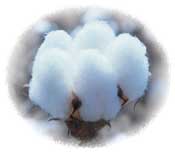Cotton Fiber
History of Cotton
Cotton is a soft, fluffy staple fiber that grows in a boll, or protective case, around the seeds of the cotton plants of the genus Gossypium in the mallow family Malfeasance. The fiber is almost pure cellulose. Under natural conditions, the cotton bolls will tend to increase the dispersal of the seeds.
 No one knows exactly how old cotton is. Scientists searching
No one knows exactly how old cotton is. Scientists searching  caves in Mexico found bits of cotton bolls and pieces of cotton cloth that proved to be at least 7,000 years old. They also found that the cotton itself was much like that grown in America today.
caves in Mexico found bits of cotton bolls and pieces of cotton cloth that proved to be at least 7,000 years old. They also found that the cotton itself was much like that grown in America today.
In the Indus River Valley in Pakistan, cotton was being grown, spun and woven into cloth 3,000 years BC. At about the same time, natives of Egypt’s Nile valley were making and wearing cotton clothing.
Arab merchants brought cotton cloth to Europe about 800 A.D. When Columbus discovered America in 1492, he found cotton growing in the Bahama Islands. By 1500, cotton was known generally throughout the world.
Cotton seed are believed to have been planted in Florida in 1556 and in Virginia in 1607. By 1616, colonists were growing cotton along the James River in Virginia.
Cotton was first spun by machinery in England in 1730. The industrial revolution in England and the invention of the cotton gin in the U.S. paved the way for the important place cotton holds in the world today.
 Eli Whitney, a native of Massachusetts, secured a patent on the cotton gin in 1793, though patent office records indicate that the first cotton gin may have been built by a machinist named Noah Homes two years before Whitney’s patent was filed. The gin, short for engine, could do the work 10 times faster than by hand.
Eli Whitney, a native of Massachusetts, secured a patent on the cotton gin in 1793, though patent office records indicate that the first cotton gin may have been built by a machinist named Noah Homes two years before Whitney’s patent was filed. The gin, short for engine, could do the work 10 times faster than by hand.
The gin made it possible to supply large quantities of cotton fiber to the fast-growing textile industry. Within 10 years, the value of the U.S. cotton crop rose from $150,000 to more than $8 million.
 caves in Mexico found bits of cotton bolls and pieces of cotton cloth that proved to be at least 7,000 years old. They also found that the cotton itself was much like that grown in America today.
caves in Mexico found bits of cotton bolls and pieces of cotton cloth that proved to be at least 7,000 years old. They also found that the cotton itself was much like that grown in America today.In the Indus River Valley in Pakistan, cotton was being grown, spun and woven into cloth 3,000 years BC. At about the same time, natives of Egypt’s Nile valley were making and wearing cotton clothing.
Arab merchants brought cotton cloth to Europe about 800 A.D. When Columbus discovered America in 1492, he found cotton growing in the Bahama Islands. By 1500, cotton was known generally throughout the world.
Cotton seed are believed to have been planted in Florida in 1556 and in Virginia in 1607. By 1616, colonists were growing cotton along the James River in Virginia.
Cotton was first spun by machinery in England in 1730. The industrial revolution in England and the invention of the cotton gin in the U.S. paved the way for the important place cotton holds in the world today.
 Eli Whitney, a native of Massachusetts, secured a patent on the cotton gin in 1793, though patent office records indicate that the first cotton gin may have been built by a machinist named Noah Homes two years before Whitney’s patent was filed. The gin, short for engine, could do the work 10 times faster than by hand.
Eli Whitney, a native of Massachusetts, secured a patent on the cotton gin in 1793, though patent office records indicate that the first cotton gin may have been built by a machinist named Noah Homes two years before Whitney’s patent was filed. The gin, short for engine, could do the work 10 times faster than by hand.The gin made it possible to supply large quantities of cotton fiber to the fast-growing textile industry. Within 10 years, the value of the U.S. cotton crop rose from $150,000 to more than $8 million.
PROPERTIES AND COTTON PRODUCTS
- Cotton is both a food and fiber crop.
- The cotton plant produces fruit, known as bolls.
- When mature the crop is picked and ginned - which separates the cotton fiber (or lint) from the seed.
- Cotton lint makes up about 42 percent of the picked cotton by weight, and contributes about 85 percent of the total income from a cotton crop. The other 15 percent of income is from cotton seed.
- Almost all parts of the cotton plant are used in some way including the lint, cottonseed, linters, stalks and seed hulls.
Natural cotton fiber properties
- Cotton is a soft, absorbent and breathable natural fiber, making it the perfect fiber for clothing and undergarments worn close to the skin
- Cotton keeps the body cool in summer and warm in winter because it is a good conductor of heat
- Cotton is non-allergenic and, unlike synthetic fibers, cotton fiber is a natural product that contains no chemicals
- Cotton, due to its unique fiber structure, breathes better and is more comfortable than oil-based synthetic fabrics
- Cotton is one of the easiest fabrics to dye due to its natural whiteness and high rate of absorbency
- Australian cotton in particular is perfectly suited to color application processes as it offers spinners crisp white lint, low breakages and stoppages, good throughput efficiency and uniformity of yarn
- Cotton holds up to 27 times its own weight in water and becomes stronger when wet
- Cotton can’t hold an electric charge, eliminating static cling
Products made from cotton
- The cotton lint from one 227kg bale can produce 215 pairs of denim jeans, 250 single bed sheets, 750 shirts, 1,200 t-shirts, 3000 nappies, 4,300 pairs of socks, 680,000 cotton balls, or 2,100 pairs of boxer shorts
- Cotton’s strength and absorbency make it an ideal fabric the production of thousands of useful products from sheets and towels, tarpaulins and tents, pharmaceuticals and medical supplies - even astronauts’ inflight space suits
- About 60% of the world’s total cotton harvest is used to make clothing, with the rest used in home furnishings and industrial products
- Cotton lint is spun then woven or knitted into fabrics such as velvet, corduroy, chambray, velour, jersey and flannel
- Cotton be used to create dozens of different fabric types for a range of end-uses, including blends with other natural fibers like wool, and synthetic fibers like polyester
- More unusual uses of cotton fiber include tents, car tire cord, fishnets and book binding
Products made from cotton linters
- Cotton linters are fine, very short fibers that remain on the cottonseed after ginning. They are curly fibers typically less than 3mm long
- Linters are used in the manufacture of paper (such as archival paper and bank notes) and as a raw material in the manufacture of cellulose plastics
- Linters are commonly used for medical supplies such as bandages, cotton buds, cotton balls and x-rays
Products made from cottonseed
- Cotton seed, which makes up around half the weight of the picked cotton, is mostly used to make cotton seed oil
- One tone of cotton seed yields approximately 200kg of oil, 500kg of cotton seed meal and 300kg of hulls
- Cotton seed oil is cholesterol free, high in polyunsaturated fats and contains high levels of anti-oxidants (vitamin E) which contribute to its long shelf life. It can be used for deep frying, and for some margarines and salad dressings. Cotton seed oil is also used to make products such as soap, emulsifiers, cosmetics, pharmaceuticals, rubber, paint, water proofing agents and candles
- The by-product of the oil-extraction process is meal, which is used as stock feed. Cotton seed meal is a high protein meal that can be fed to most animals. Cotton seed hulls are also a valuable feed source for livestock
- Global cotton seed production can potentially provide protein requirements for half a billion people and many billions of other animals







No comments